This is a level 4 algebra strand activity from the Figure It Out series.
A PDF of the student activity is included.
Click on the image to enlarge it. Click again to close. Download PDF (252 KB)
use a table to find a pattern
use a linear equation to describe the relationship
sqaure grid paper
FIO, Level 4, Algebra, Book Three, Frieze, pages 14-15
In this activity, students base their short cuts and rules on the patterns of coloured squares in the frieze designs.
In question 1, the frieze design made by painting a total of 4 x 5 + 2 squares either blue or yellow includes alternate sets each of 5 blue or yellow squares.
.gif)
The design in question 1a has 6 sets of 5 blue squares and 5 sets of 5 yellow squares. There is also 1 additional yellow square at the beginning and 1 at the end of the design. So, altogether, there are 11 x 5 + 2 squares painted blue or yellow. Note that when there is an even number of sets of 5 squares, the square at the beginning is coloured differently from the square at the end, and when there is an odd number
of sets of 5 squares, the 2 squares are coloured the same. The students will need to be aware of this difference between designs with even and odd numbers of sets of 5 squares to complete questions 1d and 1e. Students who have difficulty with question 1e might benefit from considering a design with a smaller odd-numbered short cut, for example, 7 x 5 + 2. As an alternative to drawing such a pattern, they could cover part of a larger pattern with paper or card.
In question 2, there is always 1 fewer set of 4 squares (composites of blue or yellow squares) than there are pink squares. There is also 1 additional square at the end of the design. In the first design shown for this question, there are 4 pink squares and 3 sets of 4 squares that are blue or yellow. There is also a yellow square at the end. So for 4 pink squares, there are 3 x 4 + 1 = 13 yellow or blue squares.
In the second design, there are 7 pink squares and 6 x 4 + 1 = 25 blue or yellow squares. So, a design with 100 pink squares has 99 x 4 + 1 = 397 blue or yellow squares altogether. And a design with x pink squares has (x – 1) x 4 + 1 or 4(x – 1) + 1 blue or yellow squares altogether.
In question 2b, the students must reverse their thinking to find the number of pink squares in designs with given total numbers of yellow or blue squares. They should try this for themselves and explain their thinking. The following backtracking flow chart shows the thinking involved to find the number of pink squares when
there are 301 yellow or blue squares.
.gif)
This set of three operations beginning with 301 can be written arithmetically as (301 – 1) ÷ 4 + 1 = 76.
In the frieze design in question 3, for each of the 5 pink squares, there are 4 blue or yellow squares. There are also 2 additional yellow squares.
Note that when there is an odd number of pink squares, the 2 additional squares are the same colour. When the number of pink squares is even, the 2 additional squares are different colours. So, when there are 100 pink squares, there are 100 x 4 + 2 blue or yellow squares altogether. The number of pink squares is an even number, so there are 50 x 4 + 1 blue squares and the same number of yellow squares. When there are 101 pink squares, there are 101 x 4 + 2 blue and yellow squares altogether. There is an odd number of pink squares, so there are 51 x 4 blue squares and 50 x 4 + 2 yellow squares when the first set of 4 squares is blue. On the other hand, when the first set of 4 squares is yellow, there are 51 x 4 yellow squares and
50 x 4 + 2 blue squares.
A frieze design with x pink squares has x x 4 + 2 or 4x + 2 blue or yellow squares altogether.
Answers to Activity
1a. 11 x 5 +2 = 57
b.
.gif)
c. Design for 8 x 5 + 2
.gif)
Design for 10 x 5 +2
.gif)
d. 2 501 blue squares (500 x 5 + 1)
2 501 yellow squares (500 x 5 + 1)
e. If the first set of 5 squares is blue, there is 1 more set of blue squares than there are yellow squares. There are 2 additional yellow squares:
1 at the beginning and 1 at the end of the design. So there are 501 x 5 = 2 505 blue squares and 500 x 5 + 2 = 2 502 yellow squares. (Reverse these totals if the first set of 5 squares is yellow.)
.gif)
3. A rule is: 2 plus the number of pink squares times 4. A short cut for the frieze design shown is 2 + 5 x 4 = 22 blue or yellow squares. (Each pink square is linked to
3 + 1 = 4 blue or yellow squares. There is 1 additional yellow square at the beginning of the design and 1 additional yellow square at the end of the design.
Note that when there is an odd number of pink squares, the 2 additional squares are the same colour.)
The completed table is:



